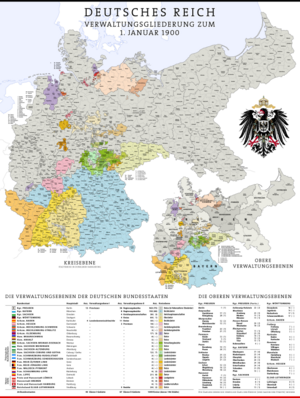Deutsches Reich[1]
German Empire
|
| Ilẹ̀ Ọbalúayé
|
|
|
|
|
Motto
Gott mit uns
(German: "God with us")
|
Anthem
None
Emperor's anthem: Heil dir im Siegerkranz
|
 Location of GermanyTerritory of the German Empire in 1914, prior to World War I Location of GermanyTerritory of the German Empire in 1914, prior to World War I
|
| Capital
|
Berlin
|
| Language(s)
|
Official: German
Unofficial minority languages: Danish, French, Polish, Frisian, Old Prussian, Silesian, Lithuanian, and other; Colonial languages: Bantu, Oshiwambo Afrikaans, and Swahili (African colonies), Chinese (Tsingtao and Jiaozhou bay), Papuan languages (German New Guinea) and Samoan (German Samoa).
|
| Religion
|
Lutherans~60%
Roman Catholics~40%
|
| Government
|
Constitutional monarchy and Limited Parilamentary Government
|
| Emperor
|
| - 1871–1888
|
Wilhelm I
|
| - 1888
|
Frederick III
|
| - 1888–1918
|
Wilhelm II
|
| Chancellor
|
| - 1871–1890
|
Otto von Bismarck (first)
|
| - 8–9 Nov 1918
|
Friedrich Ebert (last)
|
| Historical era
|
New Imperialism/WWI
|
| - Unification
|
18 January, 1871
|
| - Republic declared
|
9 November, 1918
|
| - Formal abdication
|
28 November 1918
|
| Area
|
| - 1910
|
540,857.54 km2 (208,826 sq mi)
|
| Population
|
| - 1871 est.
|
41,058,792
|
| - 1890 est.
|
49,428,470
|
| - 1910 est.
|
64,925,993
|
| Density
|
120 /km2 (310.9 /sq mi)
|
| Currency
|
Vereinsthaler, South German gulden, Bremen thaler, Hamburg mark, French franc
(until 1873, together)
Goldmark (1873–1914)
Papiermark (after 1914)
|
|
|
| Ní òní ó jẹ́ apá
|
 Burundi Burundi
 Cameroon Cameroon
 China China
 Denmark Denmark
 France France
 Germany Germany
 Ghana Ghana
 Kenya Kenya
 Lithuania Lithuania
 Marshall Islands Marshall Islands
 Micronesia Micronesia
 Mozambique Mozambique
 Namibia Namibia
 New Zealand New Zealand
 Nigeria Nigeria
 Northern Mariana Islands Northern Mariana Islands
 Palau Palau
 Papua New Guinea Papua New Guinea
 Poland Poland
 Rwanda Rwanda
 Russia Russia
 Samoa Samoa
 Togo Togo
 Tanzania Tanzania
|
Area and population not including colonial possessions
Area source:[2] Population source:[3]
|
| Warning: Value specified for "continent" does not comply
|
|




